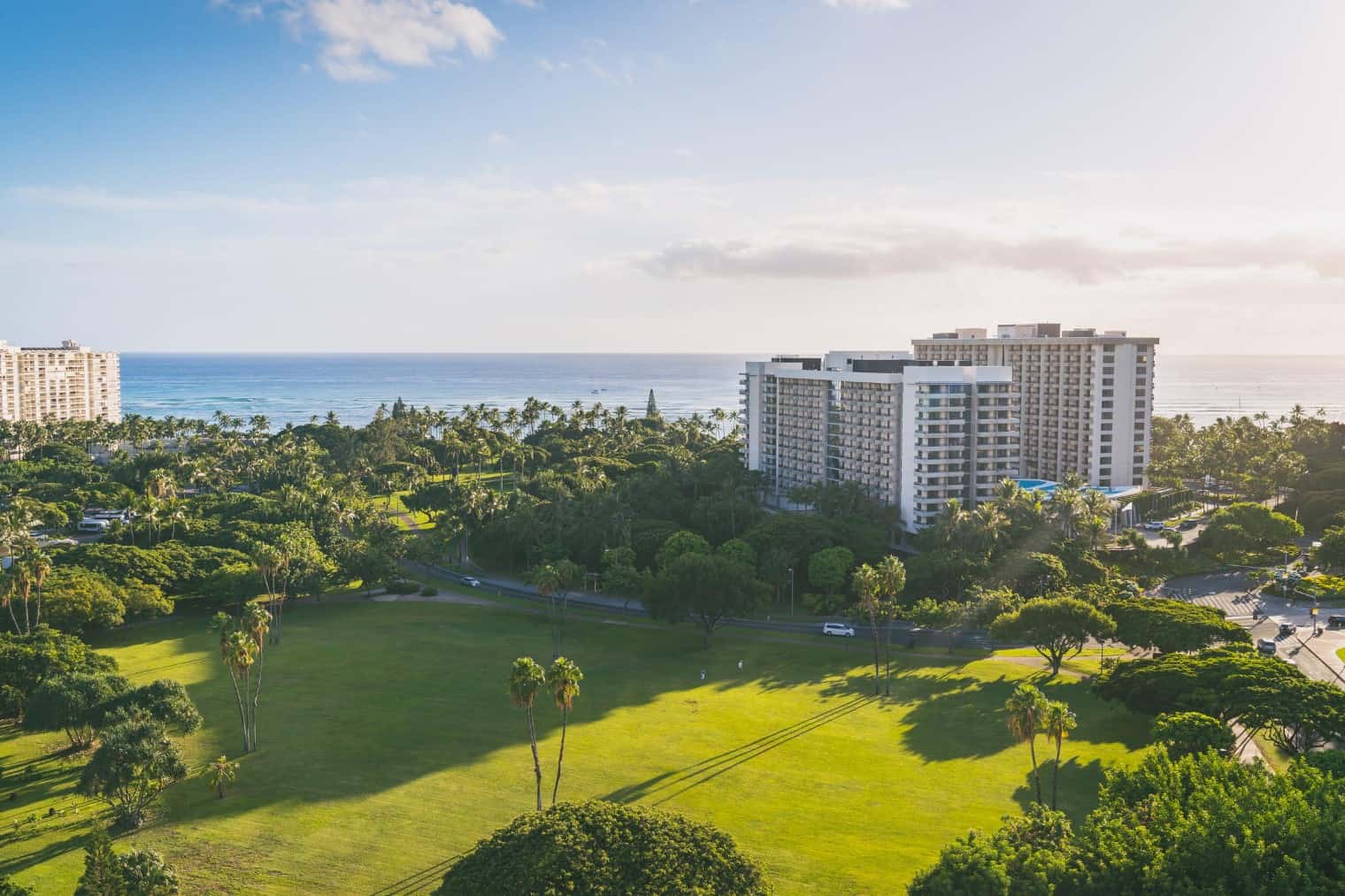Military Resort Hawaii offers a unique concept: a luxurious and relaxing getaway specifically designed for military personnel and their families. Imagine a haven where the stresses of service melt away, replaced by breathtaking ocean views, world-class amenities, and a dedicated focus on the well-being of those who serve. This exploration delves into the potential of such a resort, examining its location, amenities, pricing, environmental impact, and marketing strategies.
The concept encompasses a range of potential services, from private beach access and family-friendly activities to specialized wellness programs tailored to the unique needs of military personnel. The target audience includes active-duty military, veterans, and their families seeking a restorative and appreciative environment. The success of such a venture hinges on creating a space that not only provides respite but also fosters a sense of community and shared experience among its guests.
Defining “Military Resort Hawaii”
The term “Military Resort Hawaii” describes a type of leisure and relaxation facility specifically designed to cater to the needs and preferences of military personnel, veterans, and their families. Unlike a typical resort, a military resort in Hawaii would incorporate elements that acknowledge and address the unique experiences and requirements of this demographic. This could include specialized amenities, programming, and a supportive atmosphere.
The concept centers on providing a relaxing and rejuvenating experience tailored to those who have served or are currently serving, offering a respite from the demands of military life or a place to reconnect with loved ones in a comfortable and familiar environment. The location in Hawaii leverages the island’s inherent appeal as a desirable vacation destination, combining relaxation with the opportunity for adventure and exploration.
Existing Facilities and Services
Several existing facilities and services in Hawaii already partially fulfill the elements of a “Military Resort.” For instance, many hotels and resorts offer military discounts, recognizing the value of attracting this significant customer base. Furthermore, organizations like the USO (United Service Organizations) operate centers providing support services and recreational activities for military personnel and their families, although not exclusively in a resort setting. These existing offerings can be considered building blocks for a more comprehensive and dedicated military resort. Additionally, certain military bases in Hawaii possess recreational facilities, such as swimming pools, fitness centers, and family-oriented spaces, which, while not open to the general public, demonstrate a pre-existing infrastructure that could be expanded upon.
Target Audience
The target audience for a Military Resort Hawaii would primarily encompass active-duty military personnel stationed in or near Hawaii, veterans residing in the state, and their families. This would also include military retirees seeking relaxation and recreation, as well as military families visiting loved ones stationed in Hawaii. The resort could further expand its reach to include military personnel from other states seeking a vacation destination with special considerations for their needs. This broad target audience provides a substantial potential market.
Hypothetical Marketing Campaign
A successful marketing campaign for a Military Resort Hawaii would emphasize the unique benefits offered to its target audience. The campaign would utilize imagery showcasing the beauty of Hawaii while highlighting the resort’s specific amenities and services catering to military needs. This could include showcasing family-friendly activities, spa treatments designed for stress reduction (a common concern among military personnel), and organized group activities promoting camaraderie and social interaction. The campaign would also heavily leverage social media platforms frequented by the military community, along with partnerships with military organizations and veteran groups to ensure effective outreach. Emphasis would be placed on highlighting the value proposition of the resort—a relaxing and supportive environment specifically designed to meet the needs of those who have served or are serving their country. A key element would be emphasizing the affordability and accessibility of the resort, offering various packages to suit different budgets and needs.
Location and Amenities
A successful military resort in Hawaii requires careful consideration of location to balance proximity to military installations with access to Hawaii’s stunning natural beauty. Simultaneously, amenities must cater to the diverse needs and preferences of military personnel and their families, offering both relaxation and recreational opportunities.
Potential Resort Locations
Several locations in Hawaii offer a compelling combination of proximity to military bases and picturesque scenery. Consideration should be given to factors such as land availability, accessibility, and environmental impact. For example, areas near Joint Base Pearl Harbor-Hickam on Oahu, or near Schofield Barracks, also on Oahu, offer convenient access for military personnel stationed there. However, locations on Maui or Kauai, while further from major bases, provide a more secluded and tranquil setting, potentially attracting families seeking a more relaxed vacation. The specific choice will depend on a detailed feasibility study considering land acquisition costs, infrastructure requirements, and market demand.
Amenity Options for Military Personnel and Families
The amenities offered will significantly influence the resort’s appeal. A comprehensive range of options is necessary to cater to diverse preferences and age groups. The following table compares various amenity options:
| Amenity | Option 1 | Option 2 | Option 3 |
|---|---|---|---|
| Spa and Wellness | Full-service spa with massage therapy, facials, and body treatments | Smaller spa offering basic massage and relaxation services | Outdoor relaxation areas with ocean views and yoga facilities |
| Fitness Center | State-of-the-art fitness center with cardio equipment, weight machines, and group fitness classes | Smaller fitness center with basic cardio and weight equipment | Outdoor fitness area with calisthenics equipment and jogging trails |
| Childcare | Licensed childcare center with age-appropriate activities and supervision | Part-time childcare services with scheduled activities | Designated play areas with age-appropriate equipment and supervision during peak hours |
| Recreational Activities | Swimming pools, water sports, organized excursions (hiking, snorkeling, surfing), kids’ clubs | Swimming pool, access to nearby beaches, limited water sports rentals | Outdoor games area (volleyball, basketball), walking trails, access to local beaches |
Resort Design and Architecture
The resort’s design should reflect both functionality and the unique beauty of Hawaii. A blend of modern amenities with traditional Hawaiian architectural elements could create a welcoming and aesthetically pleasing environment. Open-air designs incorporating natural light and ventilation, coupled with locally sourced materials, would minimize environmental impact and create a sense of place. The integration of native landscaping, including lush tropical plants and flowers, would enhance the overall aesthetic appeal. For example, incorporating elements of traditional Hawaiian architecture like open lanais and thatched roofs could create a sense of authenticity and cultural connection.
Unique and Memorable Experiences
Beyond standard amenities, the resort could offer unique experiences to enhance guest satisfaction. Examples include: cultural immersion programs featuring traditional Hawaiian music, dance, and storytelling; personalized guided tours showcasing the islands’ natural beauty and historical sites; opportunities for participation in local community events and festivals; exclusive access to secluded beaches or natural wonders; and specialized programs for families, such as family-friendly cooking classes featuring local cuisine or stargazing events. These experiences would foster a deeper connection with Hawaiian culture and create lasting memories for military personnel and their families.
Pricing and Accessibility
Our commitment to providing affordable and accessible vacation experiences for military personnel and their families is paramount. We have developed a pricing structure designed to be both competitive and considerate of the diverse financial situations within our target audience. The pricing model reflects the various room types, amenities, and seasonal fluctuations.
Our pricing strategy incorporates a tiered system based on room type and occupancy. Ocean-view rooms, naturally, command a higher price point than standard rooms. Suites, offering increased space and additional amenities like private balconies or kitchenettes, reflect a premium. Seasonal pricing also plays a role, with peak season (summer months and holidays) commanding higher rates than the shoulder seasons (spring and fall). This reflects the higher demand during these periods. We also offer various packages that bundle accommodation with other services such as meals or access to resort activities, providing guests with potential savings compared to booking services individually.
Military Discounts and Special Offers
Significant discounts are offered to active-duty military personnel, veterans, reservists, and their immediate families, reflecting our deep appreciation for their service. These discounts typically range from 15% to 25% off the standard room rate, depending on the season and room type. Additional special offers may be available throughout the year, such as discounted rates for extended stays or packages tailored to specific events, such as military reunions or family vacations. For example, a “Veteran’s Appreciation Week” could offer an additional 10% discount on top of the standard military rate, incentivizing bookings during a potentially slower period. These offers are regularly advertised on our website and through military-specific channels.
Loyalty Program Benefits
Our loyalty program, “Stars & Stripes Rewards,” is designed to reward repeat guests for their continued patronage. Members accumulate points with every stay, which can be redeemed for free nights, upgrades to premium rooms, discounts on resort amenities, or priority access to popular activities. For example, 1000 points could be redeemed for a free night in a standard room, while 2000 points might secure a free night in an ocean-view room. The program also offers exclusive member-only discounts on dining and spa services. This program encourages repeat bookings, fostering customer loyalty and building a strong relationship with our valued guests. Data from similar loyalty programs in the hospitality industry shows a significant increase in repeat bookings and overall revenue generation.
Payment Methods and Booking Procedures
We offer a variety of convenient payment methods to accommodate our guests’ preferences. A bullet point list outlining the options is provided below:
- Major credit cards (Visa, Mastercard, American Express, Discover)
- Debit cards
- Military pay cards
- Cash (subject to availability)
- Travel vouchers (subject to terms and conditions)
Bookings can be made directly through our website, by phone, or through authorized travel agents. Our website offers a user-friendly booking engine that allows guests to easily search for availability, compare room types and prices, and select their preferred amenities. Our dedicated reservation team is available to assist with bookings and answer any questions. For group bookings or special requests, we encourage guests to contact our reservation team directly.
Environmental Considerations
Developing a military resort in Hawaii requires careful consideration of the unique and fragile environment. The islands’ biodiversity, natural resources, and cultural significance necessitate a proactive approach to minimize environmental impact and promote sustainability. This section details potential impacts, mitigation strategies, sustainable practices, and methods for educating guests about environmental responsibility.
Potential Environmental Impacts and Mitigation Strategies
The construction and operation of a military resort in Hawaii could potentially impact several environmental areas. For example, habitat destruction from construction is a major concern. Mitigation strategies include careful site selection to avoid sensitive ecosystems, minimizing land disturbance through efficient design, and employing habitat restoration projects to compensate for any unavoidable habitat loss. Another concern is increased water consumption. Mitigation strategies here involve implementing water-efficient landscaping, utilizing greywater recycling systems, and educating guests about water conservation. Waste management is also crucial. Strategies include implementing robust recycling and composting programs, reducing single-use plastics, and partnering with local waste management facilities for efficient disposal. Finally, the resort’s energy consumption needs to be carefully managed. Mitigation strategies include using renewable energy sources like solar and geothermal power, implementing energy-efficient building designs, and encouraging guests to conserve energy.
Sustainable Practices to Minimize Ecological Footprint
The resort can implement numerous sustainable practices to reduce its environmental footprint. These include using locally sourced building materials to reduce transportation emissions, employing sustainable landscaping techniques that minimize water and pesticide use, and prioritizing energy-efficient appliances and lighting. Furthermore, the resort can implement a robust waste management program, including composting food waste, recycling materials, and minimizing landfill waste. By partnering with local farmers and suppliers, the resort can also reduce its carbon footprint associated with food transportation. The implementation of a comprehensive environmental management system, regularly audited for effectiveness, is crucial. Examples of successful programs include LEED certification or similar sustainability standards.
Promoting Environmental Awareness Among Guests
Educating guests about the unique Hawaiian ecosystem and the importance of environmental stewardship is critical. The resort can achieve this through various initiatives. These include providing informative brochures and signage highlighting the local flora and fauna, organizing guided nature walks and educational programs led by local experts, and showcasing sustainable practices implemented within the resort itself. The resort can also partner with local environmental organizations to offer guest participation in conservation efforts, such as beach cleanups or coral reef monitoring. Finally, incorporating interactive displays and educational materials throughout the resort can subtly promote environmental awareness.
Infographic: Commitment to Environmental Sustainability
The infographic would be visually appealing and easily digestible, employing a combination of images, charts, and concise text. The title would be “Our Commitment to a Sustainable Hawaii.” The main visual element would be a stylized image of the Hawaiian landscape, perhaps incorporating native flora and fauna. Charts would display key metrics, such as percentage of renewable energy used, water consumption reduction compared to industry standards, and waste diversion rate. Sections would highlight specific sustainable practices, such as water conservation initiatives, waste reduction programs, and the use of locally sourced materials. The infographic would also include a QR code linking to a more detailed sustainability report on the resort’s website. The overall color palette would be inspired by the natural beauty of Hawaii, using calming greens and blues to create a visually pleasing and informative piece.
Ending Remarks
The vision of a Military Resort Hawaii presents a compelling opportunity to provide a much-needed haven for those who dedicate their lives to service. By carefully considering location, amenities, pricing, environmental responsibility, and marketing, a truly exceptional resort experience can be created. Such a venture would not only cater to the specific needs of the military community but also contribute to the economic and social fabric of Hawaii, fostering appreciation and understanding of the sacrifices made by military personnel and their families.




